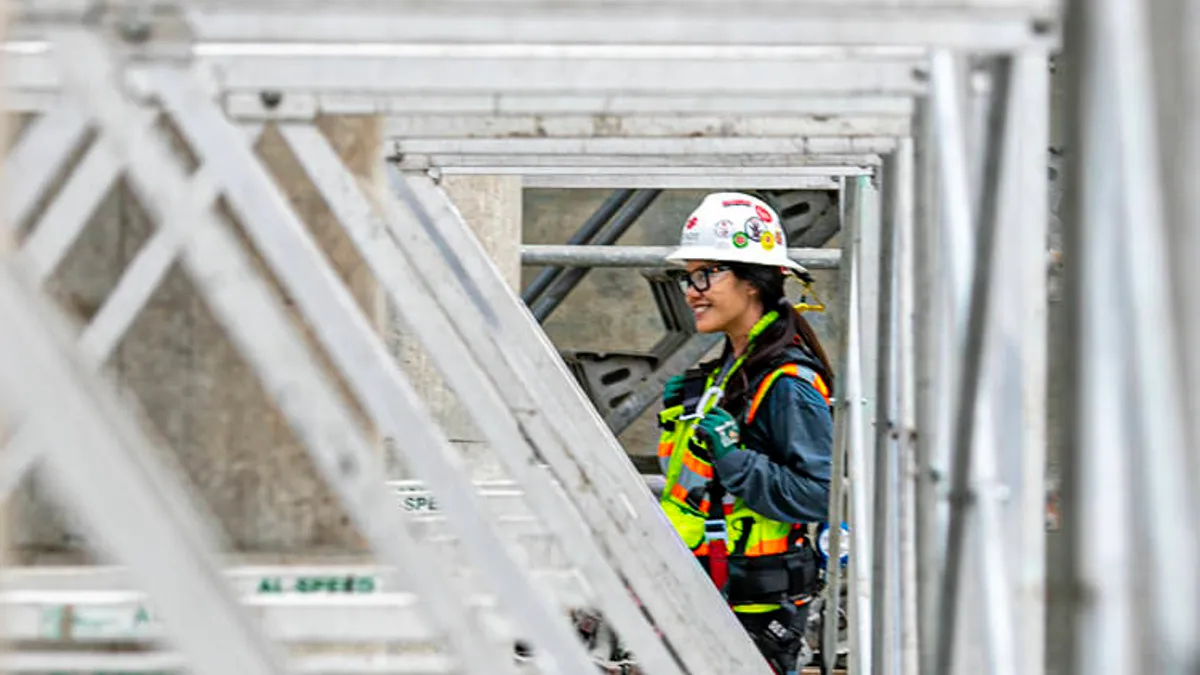Construction firms should partner with talent organizations, build inclusion and measure their progress in doing so, according to a Building Talent Foundation report issued to coincide with this year's Women in Construction Week.
Though the number of women in construction has increased over 50% in the past decade, according to a Fixr report, the percentage of men and women working in different areas within the industry varies greatly.
For example, women represent 17.1% of workers in management and professional roles, and 24.6% in subcontractor roles. But that percentage is still quite low compared to other industries, according to the Fixr report.
In the field, the imbalance is even more stark. Only 3% to 4% of jobs in production, transportation, construction and maintenance are occupied by women, according to Fixr.
Construction Dive connected with Branka Minic, CEO of Washington, D.C.-based Building Talent Foundation (BTF), and BTF research fellows Misty Farrell and Teilachanell Angel to discuss what construction firms can do to bring more women into construction.
BTF partners with employers, local associations of builders, training providers, technology platforms and workforce development nonprofits to build a diverse and sustainable workforce in construction.
Here are four steps construction pros can take right now to effectively recruit, train and retain women in the construction industry.
Sectoral development
Sectoral development programs address systemic roadblocks to education, training and work for women in construction, according to a BTF report on Women Breaking Barriers. These programs aim to both encourage women to seek careers in construction and knock down stereotypes about women not suited for positions in the construction industry.
Through an employer-led curriculum development, employers can bring focus to training in-demand skills that are needed at the moment in the industry.
For example, the Wisconsin Regional Training Partnership (WRTP) is a state-led workforce development collaborative between employers, unions and community members that connects low-income Wisconsin residents to the best family-sustaining jobs.
Minic said construction firms should also leverage technology to attract more women to the construction industry, especially those who struggle to find steady employment to provide for their families.
"For example, through social media we can reach more women and engage them in conversations about those careers," said Minic. "There are more and more providers and companies that we partner with who provide online training for construction."
The Painting Contractors Association and MT Copeland, a program that helps aspiring professionals further their careers in the building industry, both offer robust online training programs for example, Minic said.
"Some women may not be able to go to classroom training, but they could get some knowledge through these online training classes," Minic said. "Then, we can train them on the job so they can break the cycle of poverty and move forward."
Develop partnerships
While employers often advertise construction job openings, women can be hesitant to apply for these positions based on preconceived notions. When that happens, both parties are missing out on opportunities.
BTF and other collective impact organizations, which are partnerships between employers, nonprofits and communities, target that disconnect by building workforce programs focused on women and diversity.
Minic points to BTF's work with Scottsdale, Arizona-based production homebuilder Taylor Morrison, which works with contractors in 20 different markets focused on plumbing, electrical, HVAC, framing, roofing and more.
"They refer those employers to us, and we understand what type of individuals and what type of skills they are looking for," Minic said. "Then we present candidates to them that we sourced from our training providers."
Focus inclusion and safety
Many women and diverse workers don't realize construction trades are a path open to them, according to the BTF report.
Inclusive language and imagery on websites, job postings and employee materials is critical for this reason. For example, the report mentions to use words such as "tradeswomen" or "gender-nonconforming," and to intentionally debunk common stereotypes in the job postings, such as women not having the upper body strength to lift heavy objects.
At the same time, Farrell said nontraditional candidates need reassurances that construction is a safe place for them through a "total safety" approach.
Total safety goes beyond just physical safety to include both mental and behavioral health. It also means safety from harassment, intimidation, gender violence, racial violence and other forms of identity-motivated harm. Construction firms should aim to provide training on these subjects to educate their workforces, according to the report.
Workplace culture organizations that can assist with initial assessment, training and measurement include:
- RiseUp by ANEW.
- GreenDot by Alteristic.
- Empowerment Institute by Twin Cities Rise.
- MindWise Innovations.
Measure progress
Contractors should set goals to recruit from new diverse talent sources and measure that progress, according to the report.
"Organizations must use outcomes-driven measures of success, as opposed to a narrow focus on program enrollment and completion rates," said Farrell. "That's how you identify best practices and inform policy and investment decisions."
Key steps for construction firms include:
- Establish a baseline to measure future progress.
- Measure workforce demographics and representation across different stages of the employee lifecycle, compensation and pay equity, retention and attrition, opportunities for training and advancement and employee experience of inclusion and belonging.
- Disaggregate the data to form a picture of how these metrics vary for different groups.
"The path to equitable work requires a holistic approach," said Farrell. "Diversity recruiting is at start, but that alone is not going to get us there."






















